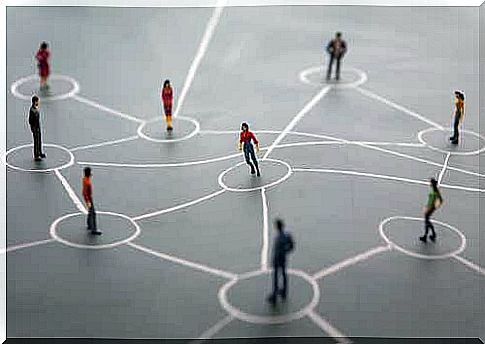History Of Systemic Therapy

To understand the functioning and relevance of its concepts, it is necessary to know the history of systemic therapy. Today, it is used by many psychologists both in the treatment of individual, couple or family problems, and in research.
The most innovative aspect of systemic therapy is the understanding of the mind as something relational, assuming a difference in relation to traditional currents that understood the origin and treatment of pathology as something exclusively individual. In turn, this shift led to the transfer of the intervention focus from the individual or the intrapsychic nature of the pathology to the interactional environment or character.
The history of systemic models in psychotherapy has been linked to that of family models, with family therapy being its most widespread field of application. Likewise, the history of systemic therapy is conceived as a pioneer in the development of brief therapy, with a short treatment duration, from 6 to 20 sessions.
The history of systemic therapy is characterized by not being linear and inherent to the constant interactions between its members, like no other model in psychology.

Background of systemic therapy
Before the development of systemic therapy, Rogers contemplated, in 1939, the inclusion of other family members in the intervention. The reason had to do with the necessary goal of Rogerian psychology to increase the individual’s understanding for better results.
The first family associations emerged in the United States in the late 30s and early 40s, under the name of “ AAMFT-American Association for Marriage and Family Therapy ”, keeping their doors open to this day.
Psychoanalysis in the first half of the 20th century pointed to the importance of family relationships in the genesis of neurosis, avoiding the therapist’s contact with the client’s family. For Freud, this would only increase the chances of violating the abstinence rule.
However, it was a psychoanalyst, Ackerman, who in 1937 published an article that focuses on how the current attitudes of family members can influence a member’s symptoms. From the 1940s onwards, contributions from other psychoanalysts, such as Eric Fromm, K. Horney and Sullivan, emerged, who went beyond Freudian orthodoxy.
In turn, Adler emphasized the role of sibling relationships in individual development, including the concept of family constellation: the weight of sibling birth order in their psychological development.
The change brought about by the shift from the intrapsychic to the interactional paradigm was one that originated thanks to social psychology and the contribution of symbolic interactionism. His ideas impacted neopsychoanalytic theories by taking into account the current psychosocial environment at the origin of neurosis and encompassing phenomena that escaped psychoanalytic approaches, such as psychosis.
In this sense, the most influential contributions to family therapy were: Fromm-Reichman, with the concept of the schizophrenic mother , Rosen, with the perverse mother , and Whitaker with the schizophrenics within the family.
The Anecdotal Emergence of Family Therapy
The idea of doing psychotherapy with family members grew out of a misunderstanding between Bell and Sutherland, who described the attachment styles – of the now famous psychologist Bowlby – when he was in England.
Upon returning to the United States, he started to use joint interviews for the treatment of childhood problems, obtaining success in the results.
Beginning of systemic therapy, 1950s
The most relevant beginnings of systemic family therapy are due to the anthropologist Gregory Bateson and his team at the Hospital de Palo Alto, who between 1952 and 1962 carried out an investigation with psychotherapists and communication theorists, developing the theory of the double bond, which is considered today a milestone in the history of psychotherapy.
Bateson’s contributions were fundamental to the beginning of systemic therapy and innovative in the history of psychotherapy by considering the mind as relational and not as an individual characteristic.
The theoretical foundations of the systemic paradigm were influenced by the disciplines that were emerging at that time, such as cybernetics, human communication theory, ecology and systems theory.
Development and expansion from the 60s onwards
The development of systemic therapy took place in the 1960s. Jackson and Ackerman founded the journal Family Process, considered a scientific communication body for systemic therapy. Along with Virginia Satir and Riskin, Jackson created the Palo Alto MRI ( Mental Research Institute ), led by Gregory Bateson, who later joined human communication theory author Wazlawick, Weakland and Sluzki.

In the 1970s, the creator of modern hypnotherapy, Milton Erickson, joined this team, while Haley publicized his method. Also at that time, Salvador Minuchin, promoted by Ackerman himself, carried out a research project with low-income families with default problems. This allowed for a highly structured style of family therapy, now known as the structural school, which turned out to be perfectly integrable into the systemic structure of the first school in Palo Alto.
Based on the work being carried out at Instituto Palo Alto , it was considered to study the patterns of communicational interaction in the change processes while analyzing how the treatment could be more efficient, that is, with a smaller number of sessions.
This line of research was born in 1967 at the Brief Family Therapy Center, led by Fish and formed by Watzlawick, John Weakland and Segal, with the aim of investigating brief family therapy.
The duration of the short treatment of 10 sessions, without pathology selection, focusing on the intervention on the problem, the use of active and very directive techniques, gave rise to the problem-centered treatment model , characterized by people’s complaints and not by the organization of the family or in developing insight. The problems were considered of an interactional type and are maintained by ineffective solution attempts, that is, the problem is the solution attempt
Solution-focused therapy, birthplace of brief therapy
The second school of systemic therapy is brief solution-centered therapy (TCS). This school was created at the Brief Family Therapy Center in Milkwaukee, through Shazer and Insoo Kim Berg, who shifted their focus from identifying patterns of interaction around the complaint to interrupting the problem sequence, as promoted by the MRI, and if they focused on what worked for the person in order to identify and amplify the solution sequences.
Solution-focused therapy sees the problem and the solution as discontinuous categories. Thus, two people can go to therapy for the same problem and generate two different solutions or, conversely, an equal solution can be obtained for two different problems.
Late 1960s, early 1970s: European schools
At the end of the 1960s, the various lines of research began to settle in Europe. Laing traveled to Palo Alto and, on his return, consolidated the line of research on the systemic model at the Tavictock Clinic in London.
In 1967, Selvini-Palazzoli and his team formed a research center in family therapy with wide repercussions for the entire international psychotherapeutic movement, considering the school in Milan, the third school of reference. Later, in Germany, a clinical service of psychosomatic medicine and family therapy was created, led by Stierlin at the University of Heidelberg.
In turn, Andolfi and Cancrini took up the systemic model and created another route of systemic family therapy, giving rise to the Rome school. All these schools maintained constant exchanges and relationships, being able to differentiate into three orientations according to their theoretical-practical foundations:
Pure systemic guidelines
Integrated by school Palo Alto, strategic school Jay Haley and Milan School. Therapy focuses on problem solving, the family unit is the object of intervention and considers the individual as a member of the family system. The family is considered an open system, governed by rules that constitute metaphors developed by the therapist to name sequences of behavior
The family system acquires these rules over time through trial and error , and they are not considered negative “ per se” , but when they become rigid and the same solutions are used compulsively and repeatedly, giving rise to the symptom.
The systems therapist has to discover how these rigid and redundant rules work to modify those that are not useful to the system, focusing on problem solving and therefore on the here and now. Contrary to the guidelines below, the therapist intervenes from the outside, as if he were an observer.
Mixed systems guidelines: Minuchin and Montalvo Structural School, Rome School and Swiss School (Kaufman)
The goals of therapy not only try to solve the problem, but also to modify the family structure, so that if problems reappear, this structure can be useful over time. This orientation is characterized by its ecological perspective.
The therapist works by becoming involved in the family system, not as a passive observer, but as an active agent of change who must carry out this restructuring. Boundaries, alliances and hierarchy are key elements of any family structure, guiding the therapist to make changes in the family structure.
Systemic psychoanalytic orientations
This orientation is composed by Ackerman , contextual therapy, Whitaker’s experiential symbolic family therapy and Robin Skinner’s groupanalytical orientation.
The family is made up of individuals, each with its own identity and personal history, and the pathology responds to the laws that govern interpersonal relationships. Although they don’t stop paying attention to the family, they consider the individual in the foreground. It is an individualistic systemic perspective. Undoubtedly, if there is something that characterizes the history of systemic therapy, it is the constant relationship between its different schools, its more practical and innovative conceptual character, and the quality of its research.
Systemic therapists are not limited to “military” their own school, but have a good knowledge of the contributions and techniques of various schools, with a predominantly constructivist and integrative perspective.
Currently, the systemic paradigm is the most used in family and couple therapy, being used in recent years in the area of health, assistance and social welfare, organizations, school problems and social networks.









